It’s time to wake up early on Saturday, October 14th, as a spectacular celestial show is coming up this weekend. A so-called Ring Of Fire – An Annular Solar Eclipse will happen across western North America, Central, and South America on Saturday morning. This unique opportunity of a rare celestial event will stretch from Oregon to Texas and continue across Yucatan to Brazil.
Saturday morning will bring quite a show for those who live from Oregon and Nevada to Utah, New Mexico, and Texas. Depending on cloud coverage, millions across the western and southwestern United States will be able to see our Moon moving across the Sun, visible as a yellow ring around the Moon. This is in the Annular Solar Eclipse or a Ring of Fire.
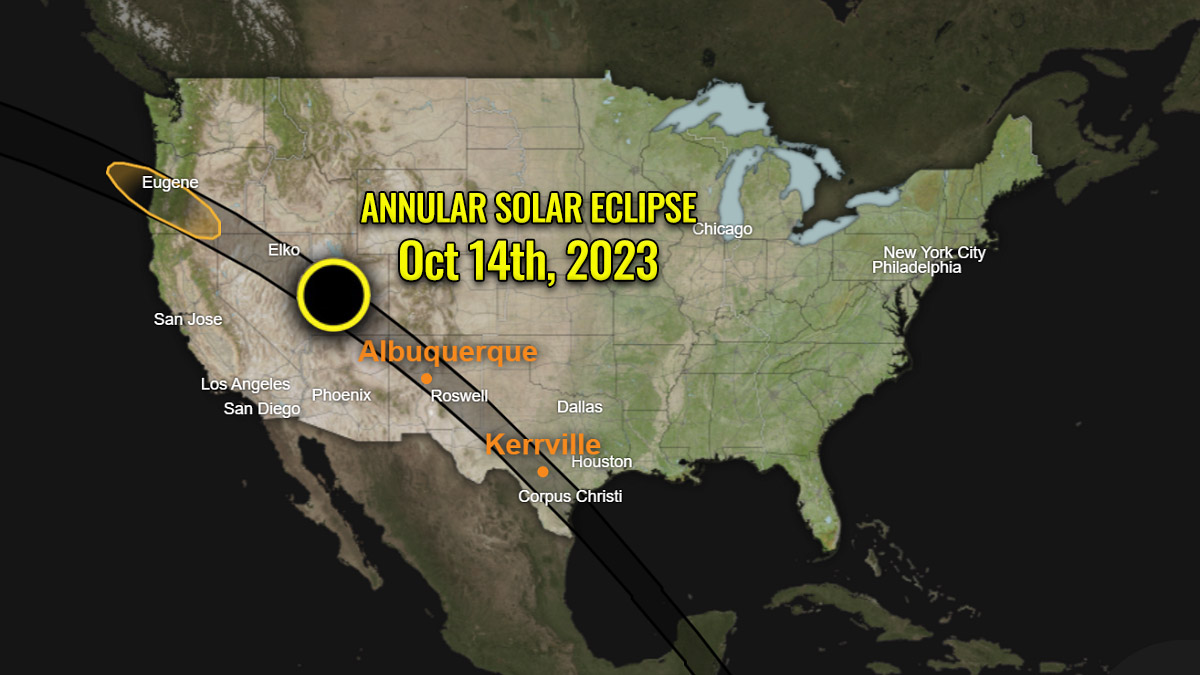
As the Solar Eclipse can only happen about twice a year, and every event is unique and happens in different, often remote areas, many people travel worldwide to experience these spectacular celestial events. Total eclipses happen even more rarely, about every 18 months.
Those who have already experienced a solar eclipse can tell you it is such a special event that you will remember it forever. A total eclipse occurs when the Moon completely obscures the Sun during daytime. But there is an even more spectacular and also pretty rare event: an annular solar eclipse.

Above: Annular Solar Eclipse in Texas, May 20th, 2012. Photo by Marko Korosec
Often, during the solar eclipse, you can hear chirping birds and see them going to roost like it is dusk; temperatures are cooler when the totality is closing in. On most of the totalities, observers reported shadow bands and even some silver tint can be seen in those. Many people chase the eclipses to experience this unique opportunity for precious minutes.
Warning: Remember, you should NEVER look directly at the sun with an unaided eye. Not even through binoculars, your camera, or a telescope, as it would cause permanent damage to your eyes. Even a short moment of concentrated light through the lens could be damaging.
What is the Annular Solar Eclipse, and How Does It Form?
As the Moon’s orbit is not perfectly circular, it rounds the Earth elliptically. This means it is sometimes closer to us but also farther away months later. There are 3 different types of shadow that the New Moon can cast on Earth: the umbra, the penumbra, and the antumbra.
When the Moon is the farthest away, its diameter appears smaller than the Sun. This is when we witness an annular eclipse, a so-called Ring Of Fire Solar Eclipse. Therefore, the Moon only partially obscures the Sun’s disc, and a tiny ring or halo appears around the Moon.
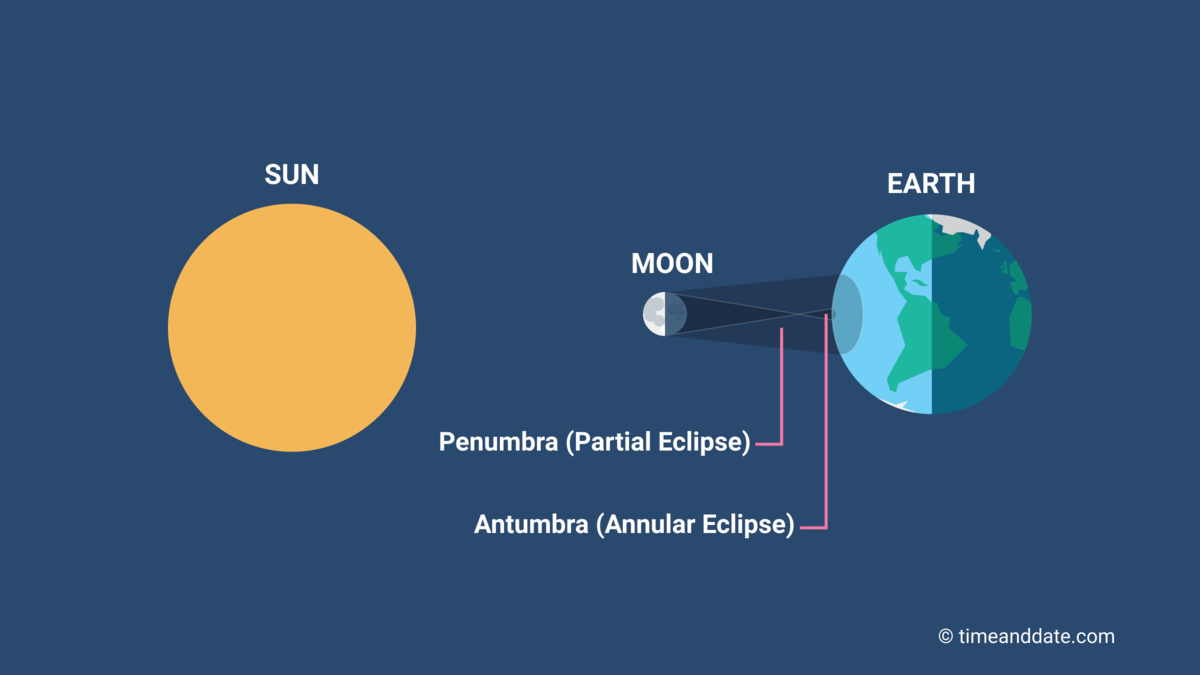
Bright light shines from this halo, making it a spectacular celestial show.
The name ‘annular’ comes from the Latin word for ring – the ‘annulus’. The eclipses are named for their darkest or maximum point, even if they only last less than a second. If the characteristic ring of fire is visible from even one location, the whole eclipse is called an annular solar eclipse.
Stages of an Annular Solar Eclipse
With th Annular Solar Eclipse, there are 5 distinct stages:
- 1st contact — partial eclipse begins: The Moon’s silhouette becomes visible in front of the Sun’s disk. The Sun looks as if a bite has been taken from it.
- 2nd contact — full eclipse, or annularity, starts: The ring of fire appears. For a few seconds, just as the annularity begins, Baily’s beads, which look like beads of light, can sometimes be seen at the edge of the Moon’s silhouette.
- Maximum eclipse: The Moon covers the center of the Sun’s disk.
- 3rd contact — annularity ends: The Moon starts moving away from the disk of the Sun. Once again, Bailey’s beads may be visible along the Moon’s leading edge.
- 4th contact — partial eclipse ends: The Moon stops overlapping the Sun’s disk. The eclipse ends at this stage.
To see the annularity phase, you must be where the Moon casts the antumbra. At the maximum point, the width of the annular path is typically around 93 mi (150 km). If you’re located in the center of this zone, you will experience the annularity’s maximum point as a perfect ring of fire.
In other areas of annularity, where the Moon is not perfectly centered on the Sun, the ring has varying widths.
If your location is at the edge of the annularity path, you may see a broken ring of fire. For a brief moment, you can also experience a phenomenon called Bailey’s beads, which are little bead-like blobs of light at the edge of the Moon. These happen because gaps in the mountains and valleys on the Moon’s surface allow sunlight to pass through in some places but not others.

Note that since there is still plenty of the Sun’s bright face showing, it is essential that we use solar filters throughout the entire eclipse. These filters must meet the transmission requirements of the ISO 12312-2 international standard. Such filters are widely available and cost only a few dollars.
The Ring Of Fire Annular Solar Eclipse 2023
The Annular Solar Eclipse on October 14th – Ring Of Fire – will be visible from the western United States, across the western Mexico Gulf, Yucatan peninsula, Mexico, and continues across eastern Honduras and Nicaragua to Costa Rica and Panama. Eclipse then continues into Colombia and northern Brazil.

Above: The path of the Annular Solar Eclipse on Oct 14th, 2023. Source: Timeanddate.com
From any area along the swath of the Annular Solar Eclipse, the Ring Of Fire halo lasts from about 4 minutes in Oregon to 5 minutes in Corpus Christi, Texas. The longest duration, about 5 minutes and 15 seconds, will be over Nicaragua and Panama. These areas will also experience a partial eclipse before and after the annularity.

Observers outside the narrow swath of the Annular Eclipse can watch the celestial event as a Partial Solar Eclipse. The closer you live to the swath of the totality, the larger part of the Sun’s disc will be obscured by the Moon.
Annular Solar Eclipse in the United States
This will be a spectacular Saturday morning for millions of Americans over the West, from Oregon across Nevada and Utah to northern Arizona, New Mexico, and Texas. Although not many could see the perfect Ring Of Fire, it will be a dramatic celestial show with clear skies.
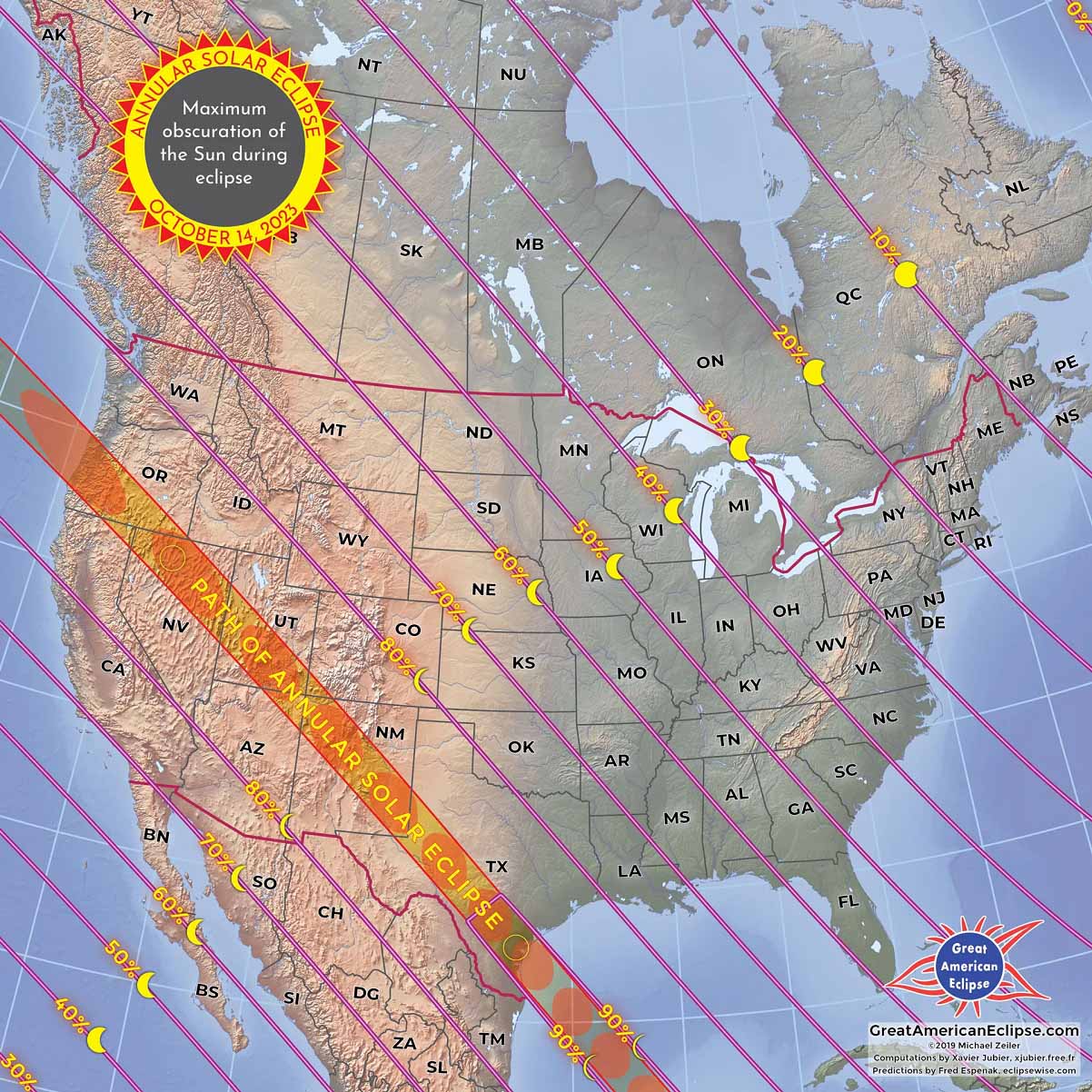
Outside the annularity, the partial solar eclipse will be visible across the whole U.S., including Canada.
The eclipse magnitude in Los Angeles, California, will reach 70%, meaning the Moon will cover around 70 percent of the Sun’s disc.
Dallas, Texas, will experience 80% magnitude, New Orleans 75%, and Chicago will get 45% of the Sun obscured. 25% of the Sun’s disc will be covered in New York, Washington D.C., and Toronto, Canada. Only 18% in Boston and Montreal.
The annular solar eclipse begins in Oregon at 9:13 a.m. PDT. The eclipse ends in Corpus Christi, Texas, at 12:03 p.m. CDT. Below are the exact times of the Partial and Annularity across different cities and states.

Eclipse across Central America
The path of the annular solar eclipse next occurs across Cancun, Mexico, and Central America, passing over eastern Honduras and Nicaragua to western Panama. The partial eclipse will be visible outside the annular phase, with the Moon covering 80%+ of the Sun’s disc.
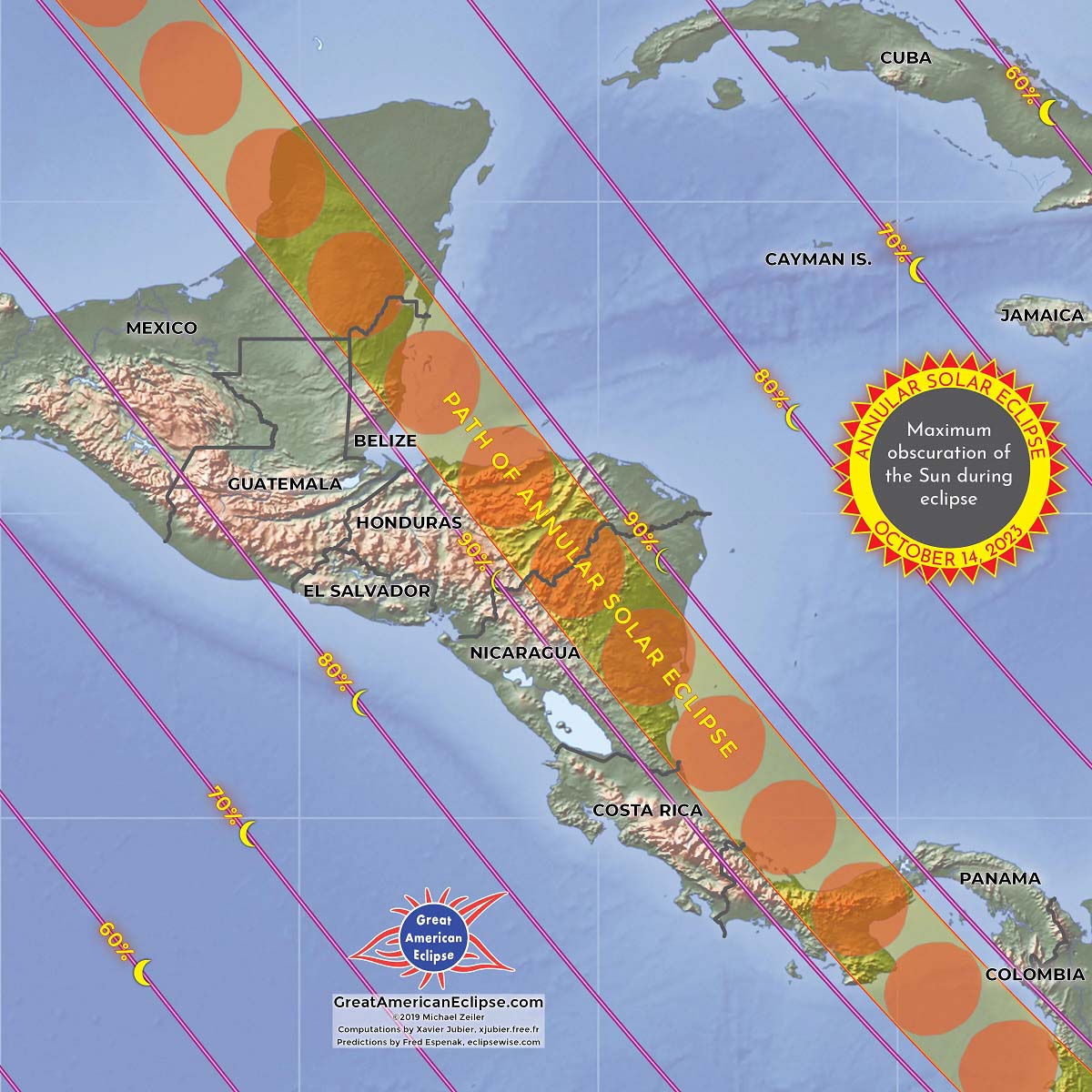
The annular eclipse then crosses into northern portions of South America.
After Panama, the annularity occurs over central Colombia and continues across Northern Brazil before it ends mid-afternoon in the Atlantic Ocean.
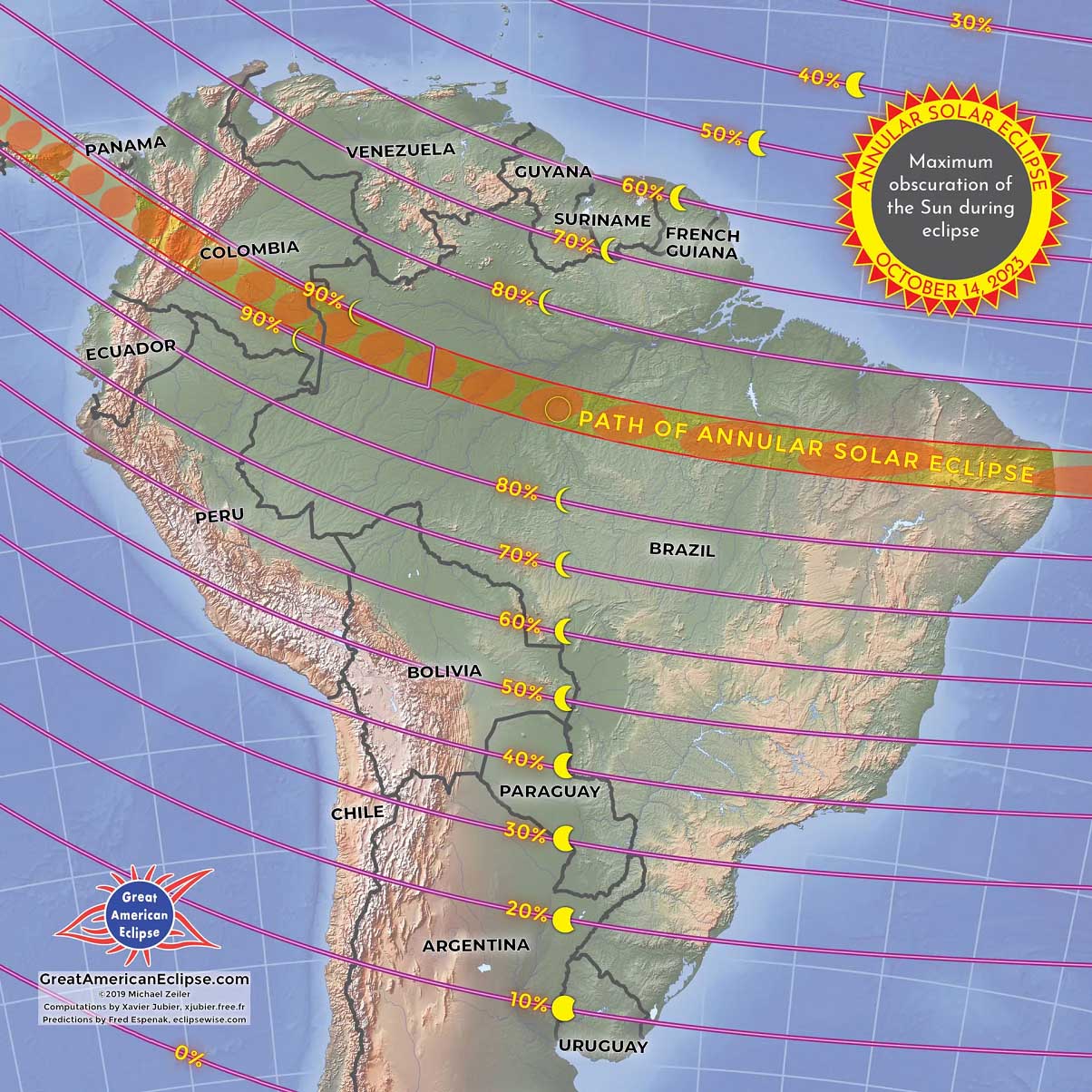
The annular eclipse in Brazil lasts about 4 minutes and 30 seconds, around 5 minutes and a few seconds in Colombia.
How is the Weather Forecast – will it be a clear sky?
Below is the cloud cover forecast for the United States and Canada. Finding a good spot with clear skies at sunrise on Saturday is a tricky chart and challenging, but there are chances.
According to the latest weather model guidance, clouds will be concerning across the Pacific Northwest, the U.S. Midwest, and the Northeast. Cloudy also across eastern and central Canada.

Better conditions are likely across Montana and Wyoming into Alberta, Saskatchewan, and areas further south across the southern Plains and the Rockies.
With the Annularity crossing Nevada, Utah, New Mexico, and Texas, conditions are quite good for observations.
Cloudiness across Central America is problematic with high moisture in the fall months, so some clear sky patches will still be possible along the path. Similar across Colombia.
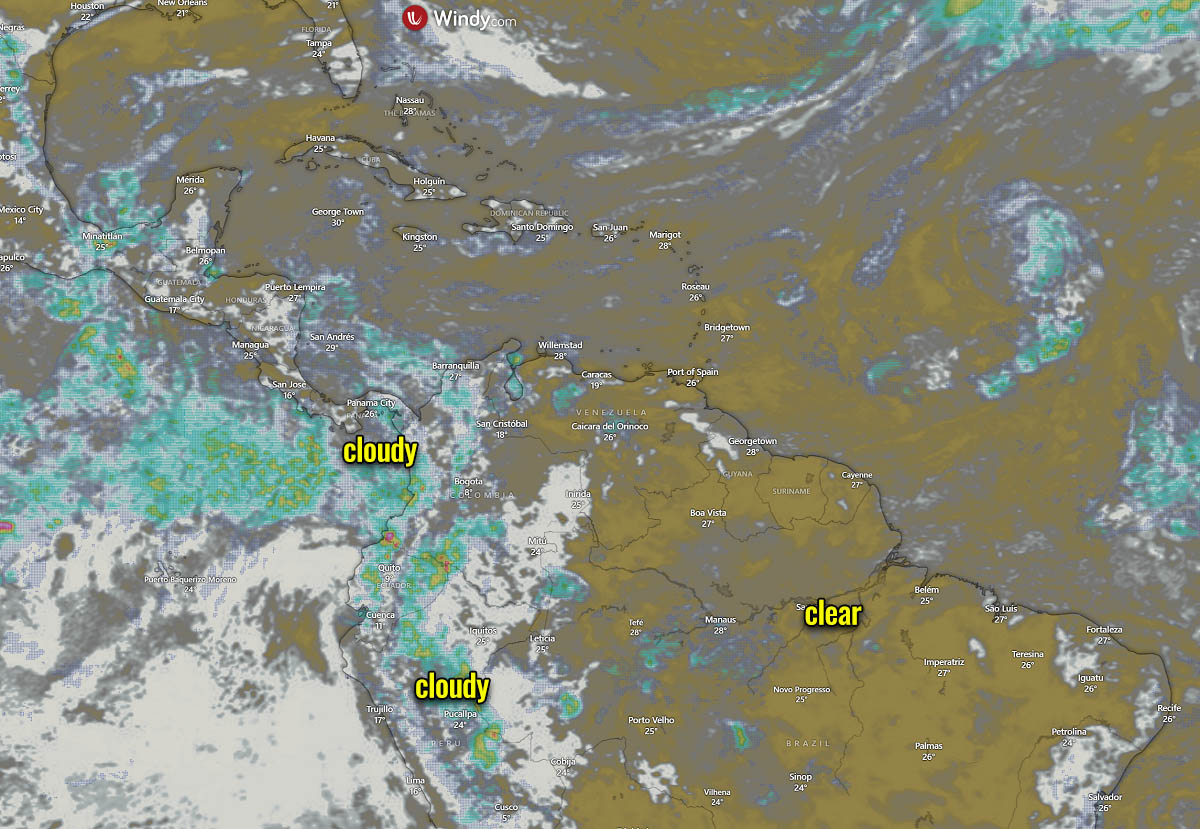
Beat conditions across South America will be across Brazil, with mostly clear skies on Saturday.
Tips How To Observe The Annular Solar Eclipse Safely
Important: Never observe the Sun with an unaided eye.
Even if you plan to observe the solar eclipse, you should buy protective solar glasses. You want to avoid messing around with the dangerous light from the Sun. The damage can happen in seconds and even make you blind if unlucky. So, here are some tips on observing the event as safely as possible.
Always, when we are just observing the Sun, whether during the full daytime or during eclipse events, you *must use solar glasses to protect your eyes. The solar glasses (or filters) should not have any scratches, punctures, torn, or damage. If you find any of those on, throw them away and buy a new one. No exception, seriously.
Always help your children and supervise them using the solar glasses if you plan to observe the eclipse with them. Although a unique opportunity for us all, a wrong moment could damage their eyes permanently.
If you normally wear glasses, put your eclipse glasses on over them. Or hold your handheld filter in front of them.
Also, do not look at the Sun through a camera, a telescope, binoculars, or any other optical device while using your eclipse glasses or handheld solar viewer. The un-eclipsed or partially eclipsed sun through an unfiltered camera, telescope, binoculars, or another optical device should never be done.
If You Plan To Photograph The Eclipse, Here is How To Do It
Photographing the eclipse might sound like a challenging thing to do, but it is actually not that difficult after all. First, remember to *always* use protective solar filters for your camera, telescope, or binoculars.
Solar glasses and lens protection
You can view the eclipse with your own eyes using the eclipse glasses. Filtered glasses will help you to aim your camera at the Sun better. Always, when photographing the Sun (no matter the sunspots or the partial, annular, or total eclipse), you will need a solar filter for your camera and lens.
Note: There is ONLY a short time when the solar filter is not needed during the total eclipse. When the Moon’s disc completely obscures the Sun, we are experiencing the totality of the solar eclipse.
This is NOT happening this Saturday, as we will experience a shining Ring around the Moon, so keep that in mind.
Above: Clooud forecast for North and south America
What kind of camera to use?
There is no need to own a special or professional camera to photograph the eclipse. Every camera on the market nowadays will do it; you need protection for the camera, especially your eyes.
The only difference the camera would make is the advantage of using a crop sensor camera versus the use of a full-frame camera. The focal length multiplier effect (normally around 1.6x) with the crop cameras results in a bigger eclipse on the pictures at the same focal length.
This basically means that you are getting a bigger (closer) look at the photographed object.
If you would like also to include the landscape on the photo beside the eclipse, then it is advised to use a wide or even ultra-wide lens (e.g., 14-24 mm). The Sun, however, will only be a small dot in your photo, but it can be a great addition to your final photo composition.
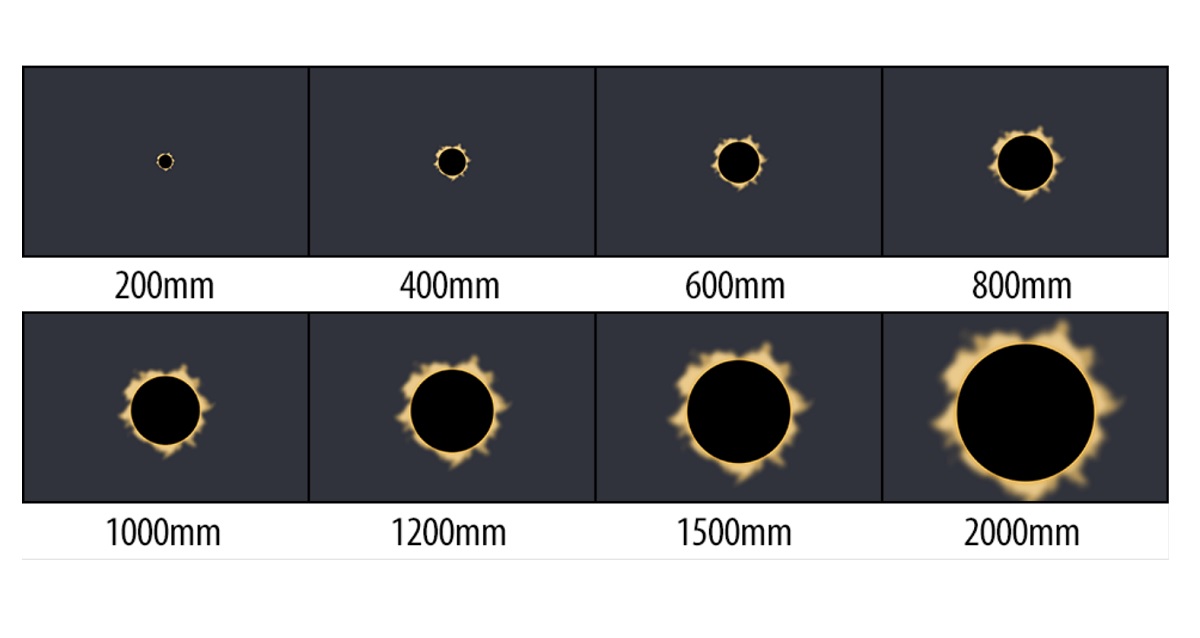
Above: The size of the eclipse depending on the focal length
If you plan to have more detailed zoomed-in shots, you obviously need to use a zoom lens. 200-600 mm lens could give you pretty good results. The longer your focal length, the better results with a larger Sun appear. Another great challenge is capturing all the eclipse phases with the zoom lens.
Experiment differently; you should come out with great results, nevertheless.
Use a tripod with a shutter release
The Sun is bright, allowing you to take photographs without putting the camera on the tripod. The shutter speeds are short (fast), so photographs shouldn’t be shaken. But it is always advised to use it, better be safe than sorry, after all.
Use a remote shutter release when taking photographs. When the Moon obscures a large part of the Sun, it quickly gets quite dark so that the shutter speeds will become longer, and you would normally use a remote shutter release to trigger your camera. You can use a remote with a cable release, electronic release, intervalometer, or mobile device.
All that helps to prevent camera shake and blurring of your images at the end. We want to have sharp photos at any time! Nothing is more frustrating than the ruined sharpness of the eclipse.
Note (although not in this case): The Sun is blocked completely when you take photos during the total eclipse. This means you are photographing in the full darkness, so a sturdy tripod is a must-have during the totality.
Final words – the Basic settings
Here are some basic settings that should normally work, although be always prepared to experiment with the settings around these basic ones. Using bracketing (taking consecutive photographs with different exposures) is helpful, too, so you can experience the proper exposure.
- Use RAW format: Avoid shooting in JPEG format. When you shoot in RAW, the photograph collects much more data, which we can use for better post-processing work later.
- ISO sensitivity: Use a native ISO; most cameras have it at ISO 100. This will give you great-quality photographs, preventing any image noise. Use higher values, e.g., 200-400 ISO only if needed, as preferred is ISO 100 given the ample light still available.
- Higher F Stop (Aperture): When photographing the eclipse, we should close the lens’s Aperture (F Stop) to f/8 or even down to f/11. These are the most preferred settings when you are also doing the close-up shooting of the different solar eclipse phases.
- Shutter Speed: If we use ISO 100 and Aperture settings between f/8 to f/11, using the shutter speed from 1/500s to 1/1000s will normally do the best results. Indeed, experiment with the shutter speed settings that will expose the photograph correctly.
When Will Be The Next Solar Eclipse?
If you are unlucky both having a cloudy morning (if living in the northeast US and eastern Canada), there will, fortunately, be more opportunities in the coming years. Although you might need to travel to some parts of your country or continents, it is worth a shot to experience this unique lifetime opportunity.
The first Total Solar Eclipse that follows this week’s event will happen in the United States again. If you live in the United States, Mexico, or Canada, you should mark your calendar on Apr 8th, 2024.
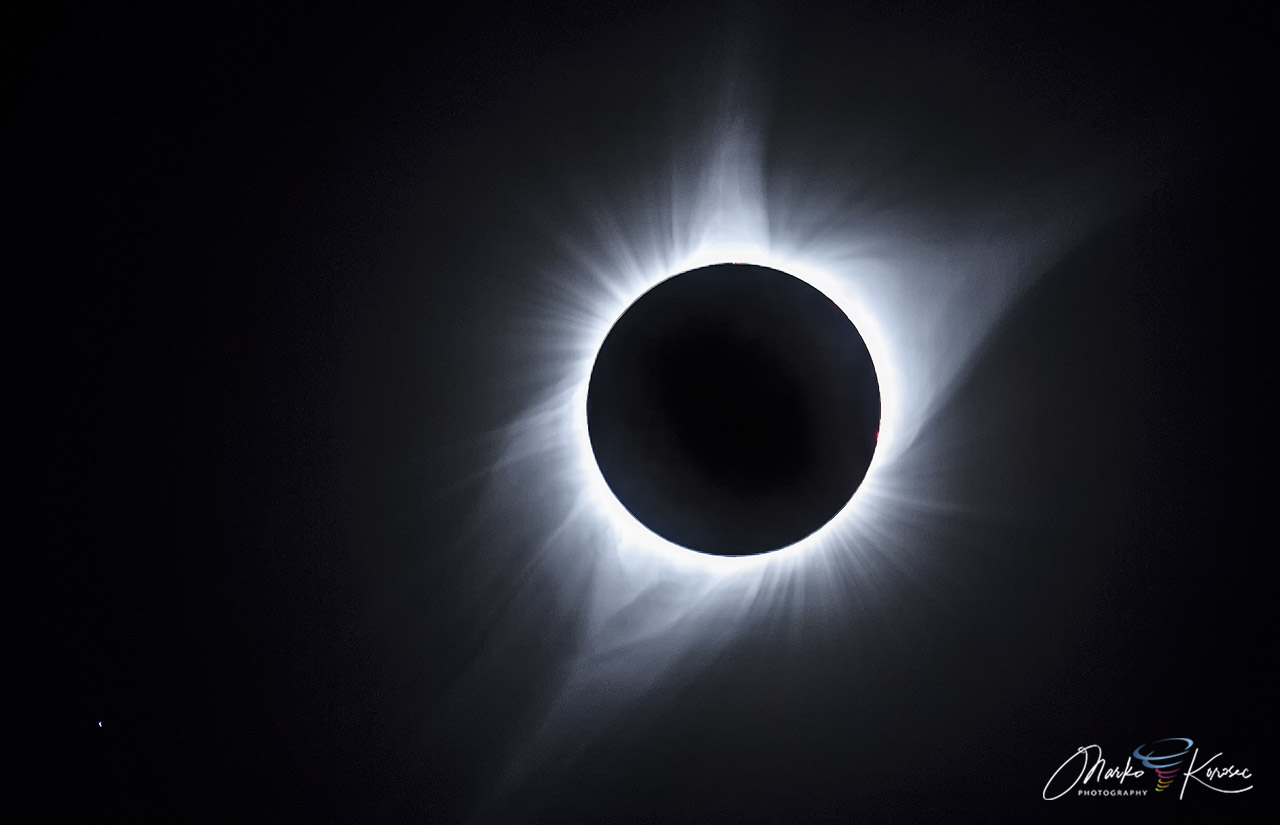
Above: Total Solar Eclipse in Wyoming, US on Aug 20th, 2017. Photo by Marko Korosec
The Moon’s penumbral shadow will spread from the Central Pacific across Mexico and the United States into southeast Canada, ending up in the North Atlantic almost to the Bay of Biscay. The Contiguous US will stretch from Texas into Oklahoma towards Arkansas, Missouri, Illinois, Ohio Valley, and the northeast United States.
The last Total Solar Eclipse happening across the United States was the Great American Eclipse on the 20th of August, 2017. It was the most-watched eclipse event in human history.
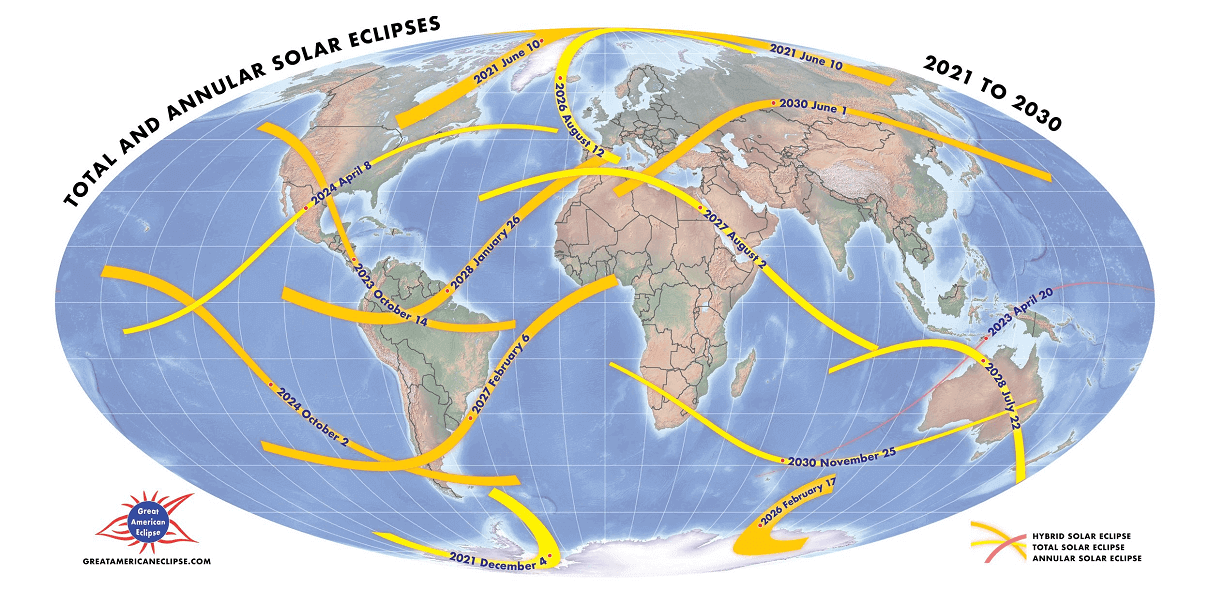
Above: Annular and Total Eclipses around the world between 2020 and 2029. Image: GreatAmericanEclipse.com
Below is the list of the events above for this decade.
- April 8th, 2024, over United States, Mexico, and Canada (Total)
- October 2nd, 2024, over South Pacific and South America (Annular)
- August 12th, 2026, over Greenland, Iceland, and Spain (Total)
- February 6th, 2027, over South America and western Africa (Annular)
- August 2nd, 2027, over northern Africa, Gibraltar, Egypt, and the Saudi peninsula (Total)
- January 26th, 2028, over Peru, Brasil, central Atlantic, and Spain (Annular)
- July 22nd, 2028, over Australia and New Zealand (Total)
- June 1st, 2030, over Algeria, Greece, Russia, and Japan (Annular)
- November 25th, 2030, over southern Africa and Australia (Total)
As we see from the list above, the next big Total Solar Eclipse for Europe will be on the 12th of August, 2026. The swath of totality will sweep through the western Mediterranean, Spain, and across the northeast Atlantic to western Iceland and eastern Greenland. The partial eclipse will be seen over most of Europe.
Actually, it is quite challenging that eclipses visit the same places (or countries) around the world. It could happen once in a century. So if you are dedicated to seeing one, some travel will be needed to catch the next one, unless you are very lucky living on its exact track.
Good luck with the clear skies, and have fun observing this year’s Annular Solar Eclipse!
NationalEclipse.com, NASA, and Windy provided images used in this article.
See also: